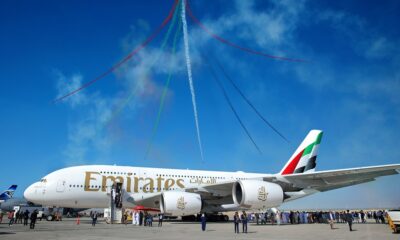Most Viewed ;
Emirates announces A380 service to the French Riviera, adds Monaco transfers by helicopter
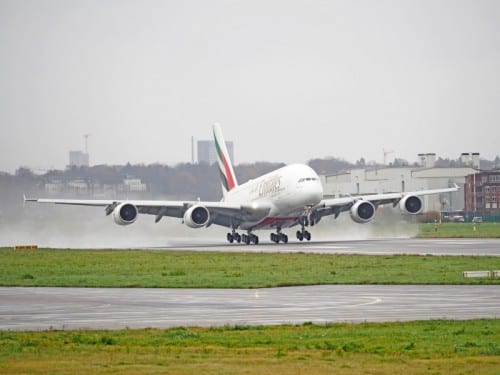
First and only airline to operate an A380 to Nice Cote d’Azur Airport Capacity increase to support the region’s growing business and tourism sectors
Supporting job creation by improving connectivity with the rest of the world
Eligible passengers to benefit from complimentary Monaco transfers by helicopter*
Dubai, UAE – 23rd March 2017 – Emirates announced today the launch of a daily A380 service to Nice, gateway to the French Riviera and Provence. The daily A380 service will start on 1st July 2017, just in time for the beginning of the summer holiday season. After Paris, Nice becomes Emirates’ second destination in France to welcome the iconic double decker, further stimulating demand for travel to the region.
Nice is currently served with a daily flight operated by a Boeing 777-300ER. The deployment of an A380 represents a capacity increase of 44% on the route. With 3633 weekly seats in each direction, Emirates will offer more seats to the Middle East and beyond than any other international airline, highlighting Nice’s importance as part of the airline‘s global network. Enabling an increase in passenger numbers will also result in additional tourism revenues for Nice and the wider region, which in turn will mean boosting the local economy and job creation.
“Emirates started flying to Nice on 15th July 1994, almost 23 years ago. Since then, almost two million passengers have travelled with us on the route, with over 200,000 last year alone. We’re excited to see the city join the other 46 destinations Emirates currently serves with the A380 and look forward to being the first airline to fly this iconic aircraft to Nice,” commented Thierry Antinori, Emirates’ Executive Vice President and Chief Commercial Officer. “We expect the A380 service to further grow the number of leisure and business travellers that visit the south of France throughout the year,” added Antinori.
As of 1st July, EK77 will be operated by an A380, leaving Dubai at 0845hrs and arriving in Nice at 1340hrs, while EK78 will depart Nice at 1540hrs and arrive in Dubai at 0010hrs the next day (local times). Passengers travelling to or from the following cities will enjoy optimal A380 to A380 connections in Dubai: Aukland, Bangkok, Hong Kong, Mauritius, Seoul, Shanghai, Sydney, Taipei, Tokyo, and more.
“I am thrilled to welcome the A380, a prestigious and iconic aircraft. Nice will be the only city in France, other than Paris, to boast a scheduled A380 service. The team at Nice Cote d’Azur Airport worked tirelessly to ensure a smooth arrival, from runway optimisation to boarding bridge modernisation. Emirates’ decision to upgrade its daily service to Nice confirms the appeal of our region, important enough to sustain a year-round long-haul flight,” commented Dominique Thillaud, President, Cote D’Azur Airports.
*Travelling to Monaco? Arrive in style with Emirates‘ helicopter transfers offered in partnership with Monacair
As part of its commiment to offering the best travel experience to its passengers, Emirates is working with Monacair to offer helicopter transfers between Nice Airport and Monaco, including a limousine service from Monaco’s heliport to their final destination. The service will be complimentary to First Class passengers, €79 per passenger for Business Class and €109 per passenger for Economy Class.
World class service from Skytrax’s “World’s Best Airline 2016”
Emirates operates one of the youngest and most modern fleets in the sky, with an average fleet age of just 61 months, compared to the industry average of 140 months. Emirates’ Airbus A380 aircraft serving the Dubai-Nice route will offer high levels of comfort and high-quality service: a total of 519 seats in a three-class configuration, with 429 spacious seats in Economy Class on the main deck, 76 fully flat-bed mini-pods in Business Class and 14 First Class Private Suites on the upper deck. In all classes, Emirates passengers enjoy spacious seating and the excellent service delivered through our multilingual cabin crew. Business Class and First Class passengers also benefit from a complimentary chauffeur-drive service as well as access to Emirates’ global network of airport lounges.
As with all Emirates flights, passengers will enjoy the extra generous Emirates baggage allowance of up to 35kg in Economy Class, 40kg in Business Class and 50kg in First Class.

Airlines
These are the 5 oldest airlines Still Operating in the World
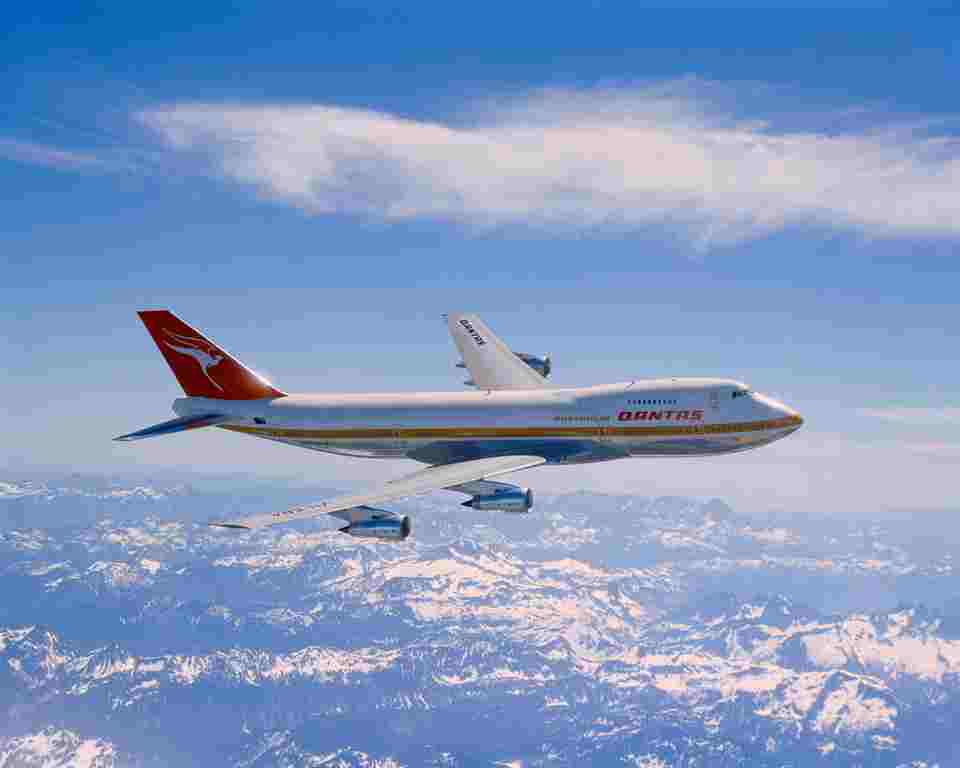
The history of aviation is an exciting adventure formed by the pioneering efforts of several individuals and organizations. The world’s oldest airlines, which have played a vital role in establishing the global travel sector, are among these trailblazers.
In this article, we will explore the five oldest airlines still in operation today, highlighting their remarkable journeys and enduring legacies in the world of aviation.
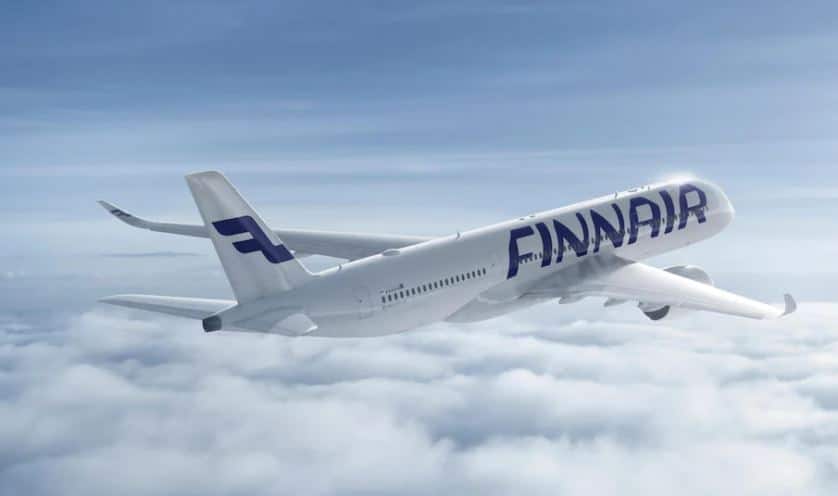
1. Finnair:
Founded: November 1, 1923
Headquarters: Vantaa, Finland
Primary Hub(s): Helsinki Airport
Fleet Size: 84
Destinations: 132
As a pioneer in European aviation, Finnair, founded in 1923, Marked its remarkable centennial milestone on November 1, 2023. Being among the oldest airlines in Europe, Finnair has witnessed many changes over the past 100 years, going from a small regional airline with few routes to a global leader in both air travel and hospitality.
Finnair’s adaptability has been demonstrated by its ability to quickly adjust to recent geopolitical developments and continue providing clients with exceptional service in its distinctive Nordic manner, even as it expands its services to North America and Southeast Asia.

2. Qantas:
Founded: November 16, 1920
Headquarters: Mascot, Sydney, Australia
Primary Hub(s): Brisbane Airport, Melbourne Airport, and Sydney Airport
Fleet Size: 130
Destinations: 85
Qantas is Australia’s flag carrier and the country’s and Oceania’s largest airline in terms of fleet size, overseas flights, and international destinations. It is the second-oldest airline still in operation.
Australian carrier Qantas holds its name among the oldest airlines in the world, with its foundations dating back to November 1920. Recently On November 16, 2020, QANTAS celebrated its remarkable centenary.
3. KLM Royal Dutuch Airlines
Founded: October 7, 1919
Headquarters: Amstelveen, North Holland, Netherlands
Primary Hub(s): Amstelveen, North Holland, Netherlands
Fleet Size: 116
Destinations: 145
KLM, officially known as KLM Royal Dutch Airlines, is the world’s oldest airline that is still in operation under its original name. On October 7, 1919, the company was founded. Four years ago, On 07 October 2019, KLM celebrated its remarkable centenary. As an airline from the beginning of the 20th century, it survived World War II and is currently part of the Air France-KLM company.
4. Aeroflot
Founded: February 3, 1923
Headquarters: Moscow, Russia
Primary Hub(s): Sheremetyevo International Airport
Fleet Size: 247
Destinations: 146
Aeroflot is Russia’s national carrier and largest airline. It is also Eastern Europe’s oldest airline, having been founded in early 1923. DOBOROLET, or The Russian Society for Voluntary Air Fleet, was the airline’s original name.
Aeroflot concentrated on foreign routes out of Moscow when the airline was separated into several enterprises. In celebration of its 100th anniversary in 2023, Russian airline Aeroflot (SU) recently began a series of retro-style flights, transporting customers on a nostalgic journey through time.
5. Avianca
Founded: December 5, 1919
Headquarters: Bogotá, Colombia
Primary Hub(s): El Dorado International Airport and San Óscar Arnulfo Romero International Airport (Avianca El Salvador)
Fleet Size: 102
Destinations: 114
On December 5, 2019, Avianca commemorated its 100th anniversary. The airline was founded in late 1919, according to its history. After acquiring a number of airlines in nearby nations, Avianca has grown to become one of Latin America’s biggest airline groups, with a fleet of over 130 aircraft and a network of subsidiaries covering almost the entire continent.
Aviation
World’s Top 21 riskiest Travel Destinations – U.S. State Department’s Level 4 Advisories”

The US government provides travel advisories to warn its citizens about the safety and security circumstances in numerous places across the world. These recommendations are intended to assist travelers in making informed decisions and minimizing risks while abroad.
While many countries are typically safe to visit, the US Department of State advises exercising caution or avoiding travel altogether owing to a variety of concerns such as political instability, terrorism, and natural disasters.
Travel advisory levels are released by the U.S. State Department for over 200 countries worldwide. These levels are updated regularly depending on a range of risk factors, including health, terrorism, and civil unrest. Level 1 travel advisories advise taking standard precautions, while Level 4 advisories advise not going there.
As of October 23, over 10% of countries—21 in total—had a Level 4: “Do Not Travel” advice. The State Department states that in Level 4 countries, the United States government may have “very limited ability” to take action if travelers’ security or safety is in risk.
Places With a Level 4 Travel Advisory
Afghanistan: According to the State Department, the Central Asian nation is dealing with “armed conflict, civil unrest, crime, terrorism, and kidnapping.”
Burkina Faso: This West African country is plagued by crime, terrorism, and kidnapping. With little to no notice, schools, restaurants, and hotels may become targets of terrorist strikes.
Myanmar (formerly known as Burma): The main barriers to visiting this Southeast Asian nation are civil chaos and armed conflict.
Gaza: Due to the current conflict, US officials advise visitors to Israel, the West Bank, and Gaza to either postpone their plans or stay away.
Iran: All visitors are at danger for kidnapping and unjust detentions, but Americans are particularly vulnerable to “arbitrary arrest and detention.”
Iraq: The State Department bases its Level 4 designation on “terrorism, kidnapping, armed conflict civil unrest.”
Libya: Conflict between armed groups in Libya’s East and West has plagued the country since the fall of its dictatorship over a decade ago.
North Korea: is home to one of the longest-running dynastic dictatorships in history, and US passports are not valid for travel “to, in, or through” this nation.
Russia: The invasion of Ukraine, arbitrary law enforcement, and intimidation of American citizens by Russian government officials are among the factors that led to the country’s Level 4 travel recommendation.
South Sudan: Weapon assault, kidnapping, and crime are the main risk factors, with violent crime being widespread in the nation.
Sudan: Due to the continued turmoil in the nation, the United States withdrew its embassy from Khartoum in April 2023 and blocked its airspace.
Yemen: Yemen has six of the nine risk categories listed by the State Department: landmines, terrorism, civil instability, health hazards, and kidnapping.
Malawi: Level 2
The Department of State is warning visitors to Malawi to travel with extra caution in light of recent criminal activity and civil upheaval.
Bangladesh: Level 2
US residents who are in Bangladesh or intend to travel there should be especially careful because of the country’s high crime rate, terrorist attacks.
Saba: Level 1
The most recent alert states that visitors to Saba should take standard safety precautions.
Aerospace
A Peek Inside BOEING 777X Test Flight at Paris Airshow.

Have you ever wondered, How aircraft undergo the process of earning final approval certificates from the FAA or EASA for passenger flight operations after testing?
Let’s have a look at it in the article below. Before building a physical model, the aircraft undergoes extensive design and material selection. As well as testing to determine its requirements and viability.
Jetline Marvel received permission to visit the inaugural Boeing 777-9 at Paris Airshow 2023. Granting a unique opportunity to glimpse the typically undisclosed aspects of the aerospace industry..
Boeing redesigned the Boeing 777x and B737. Giving them a more contemporary appearance, more spacious cabin, and more sophisticated amenities than the models that came before.

Take into consideration that the aircraft has an even larger engine to increase its speed and carrying capacity. The massive fan is only marginally smaller than the fuselage of a Boeing 737, with a diameter of 128 inches. The GE90-115B held the title of the world’s largest jet engine. Until the introduction of the even larger GE9X for the 777X. Although the engine has a diameter of 134 inches, it does not have the same thrust as the GE90.
Safety in the Skies: How Boeing Ensures Airworthiness Through Testing
Boeing’s 777X test planes, Including the 777-9 variant, feature a range of instruments and systems tailored for flight testing and validation.
These test aircraft assess the aircraft’s performance, safety, and compliance with regulatory requirements before it is ready for commercial service. Here are some of the key components and features typically found inside a Boeing 777X test plane.
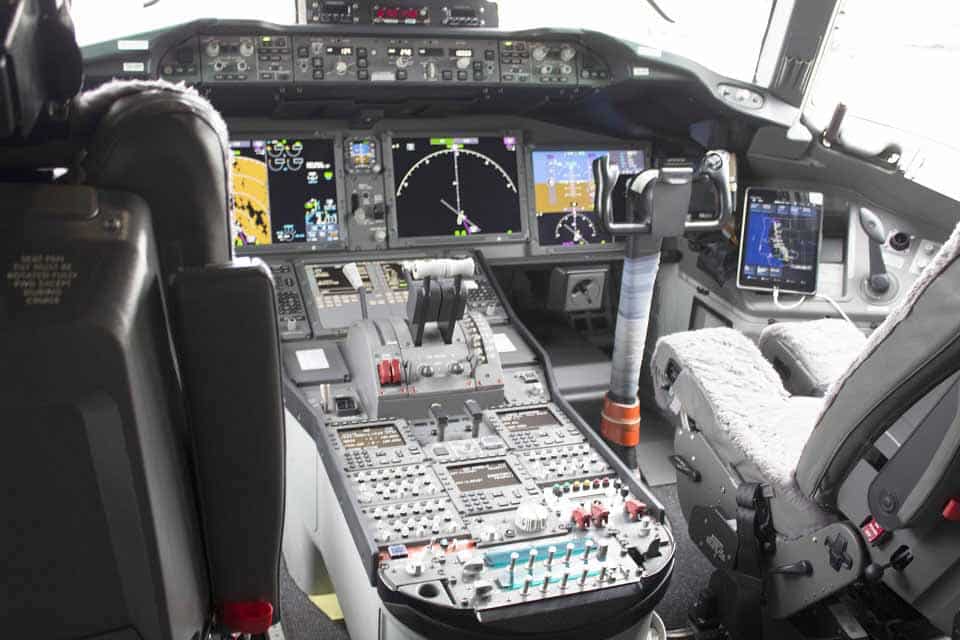
Flight Testing the Boeing 777X and B737: What Goes Onboard
Boeing 737-10 and Boeing 777 planes are experimental aircraft. Which are the forthcoming Boeing family aircraft that are currently in the testing process. The B737 Max has undergone minor fitness improvements. Boeing 777X is presently undergoing critical testing phases for its components, with an anticipated completion timeline of another 18 months.
Both aircraft arrived at the 2023 Paris Airshow. They permitted a few reporters to take a look inside the plane. It appears incredible to view the experimental airplane.
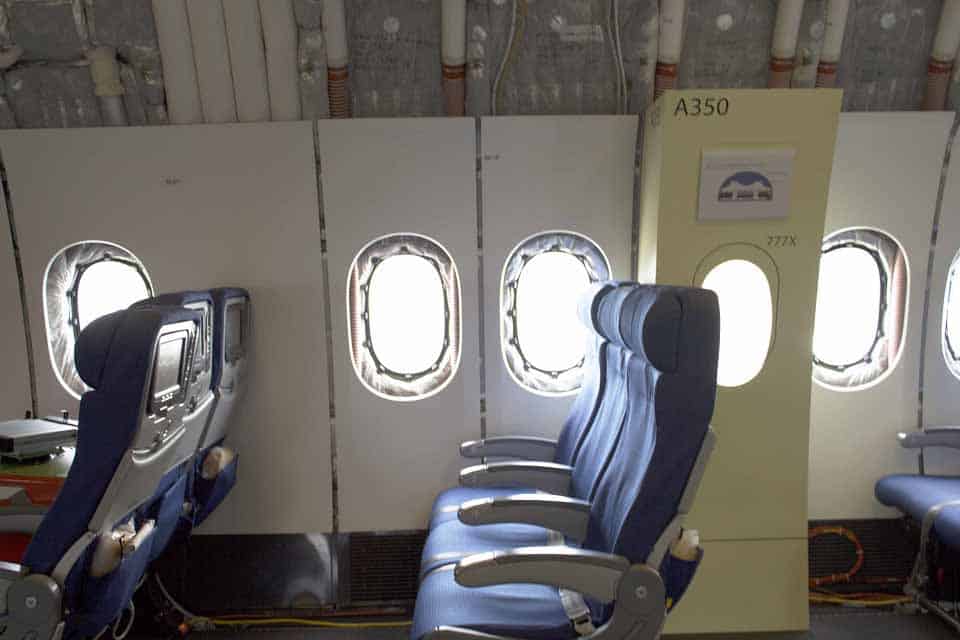
From Instruments to Ballast Tanks: The Tools of Aircraft Certification
The interior is designed to accommodate over 400 passengers in a standard two-class commercial layout. Resembles a vast, open space filled with numerous instrument racks.
Even the lateral walls, were devoid of wall finishings and fixtures. contributed to the overall work-in-progress feel of the space.
The large tanks you can see in this photo are at the back of the aircraft and serve a number of important functions for it to understand its own motion.
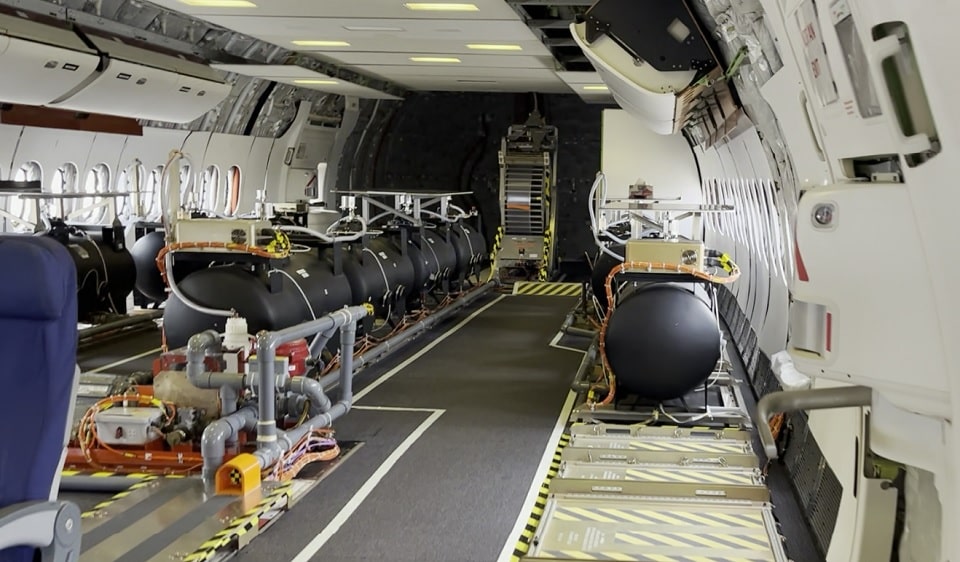
To achieve the required balance when the center of gravity of an aircraft or ship falls outside specified tolerances or the designated position, operators use ballast, which primarily consists of rubber or sand.
Engineers need to transfer water between the tanks to calculate the maximum weight balance of the aircraft under cruising conditions.
Difference between the Airbus A350 and B777x
Here is the difference between the Airbus A350 and B777x fuselage size which is quite bigger than A350 aircraft and the windows are slightly larger as well.
The cockpit boasts a modern design and incorporates cutting-edge avionics and engine features, elevating the aircraft’s capabilities.
In the aircraft, there are seats in the middle and on the right side, all of which come with soundproof covers. One of the middle seats also has a sensor installed. The left and right sides of the cabin have designated walking areas.
The difference between the Airbus A350 and B777x can be found in this article.

Furthermore, if you continue moving to the rear, you will notice some of the tanks that will be filled with water based on their weight
On the right side, we can see one of the engineers can sit and monitor the sensors and outside views. Most of the seats in the airplane are in the middle, where computers and sensor panels are arranged along with all the wires and sensors.
according to the weight load balance during the flight test mode. Internally coupled with pipers and pressure tanks, the tanks can instantaneously flow water within each other.

As we move back, we can see one of the controllers, which is usually used to manage the water lines.
At the back end, we can see the fuselage encased and insulated with soundproof materials, which works as a shield for the aircraft fuselage.
There are approximately four tanks on each side of the row, with around twelve tanks at the back end. We can see outside from the plane’s window and door.
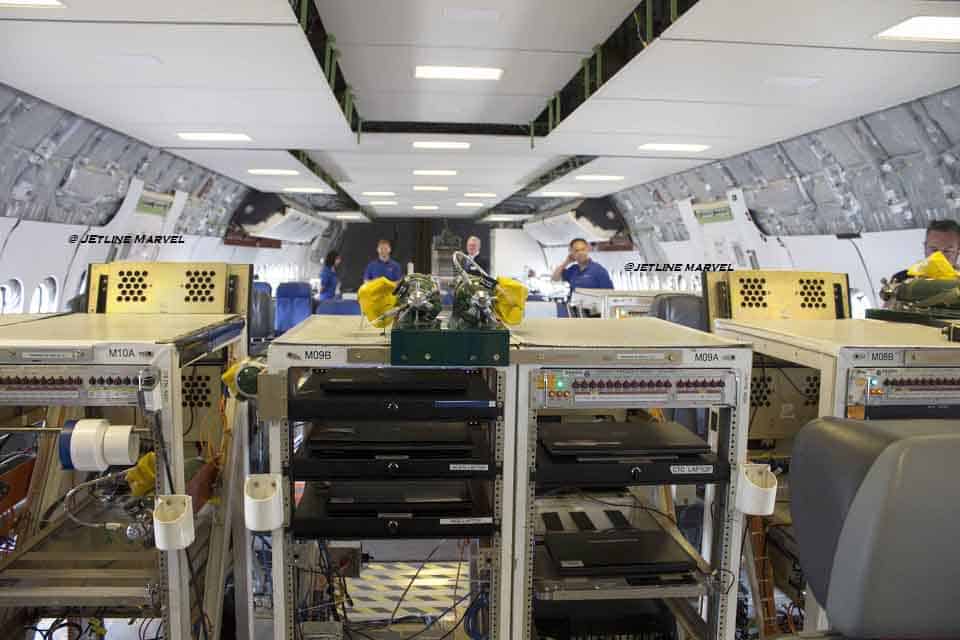
More computers and sensor monitoring chambers appear as we proceed. Engineers’ tasks are critical since they ensure that each test phase is completed. Some of the other journalists are shooting pictures inside the plane.
The aircraft looks impressive even prior to the installation of its seats. Understanding the variations in the aircraft’s data is made possible by the fact that the majority of the sensors are connected to different parts of the aircraft.
Furthermore, the aircraft is being equipped with the following types of instruments and equipment:
- Flight Test Equipment: Test planes have special tools and sensors to gather data about how well the aircraft works. They look at things like how it flies, its technology, and how strong it is.
- Controlling the Aircraft: They check if the systems that control the plane, like the fly-by-wire system, work the right way and are safe.
- Measuring Stress and Load: Sensors are put in different parts of the plane to see how much stress and pressure it can handle during the tests.
- Engineers on Board: Engineers are on the plane to keep an eye on everything, collect data, and make decisions during the tests.
- Computer Programs: They use special computer programs to study the data from the tests. This helps them see how well the plane is doing and what they can make better.
- Special Tools: Sometimes, they use special equipment, like tanks filled with weights, to copy different conditions during the tests.
- Safety First: Safety is a big deal, with backup plans and systems to keep the test crew and the plane safe.
- Like a Prototype: The test plane is like a prototype or an early version of the plane, so it might not have all the fancy features and systems of the final passenger plane.
Please share your thoughts on this article in the comments section. We would also be interested in hearing about any suggestions you may have for future aviation-related articles.





